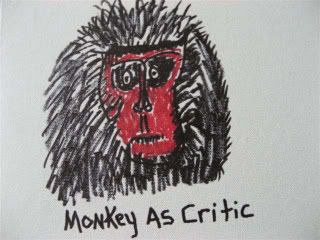Monkey See, Monkey Do
I have three basic rules for reviewing art. They address the content, the craftsmanship, and the consistency of the work. Making art does not involve “magic,” nor does writing about it. What’s needed is an experienced eye, clear thinking, and, unless you are some kind of whiz kid, long hours. Computers are great tools, but I know of none that “think.” We live in a world fraught with “information” rushed to deadline: words mashed and tangled beyond recognition, words spewed from press release re-writes. Angry words, dumb words, and here and there, intelligent words shaped into cohesive thoughts before they are fired into space. I’m a big fan of the latter.
All of this chaos makes me ponder the role of the art critic. Those two words, art critic, are attached to responsibilities, and words devoid of thought are zero. It’s easy these days to plunder websites (so many, so diverse) and pack a review with clever asides, so as to create the illusion that the writer has been thinking. Oh well, (you say), the virtual universe has infinite space, so what’s the excuse for not giving as many folks as possible their fifteen minutes of online fame? What’s the harm?
Brain dead coverage is the harm. Description without opinion or conclusions well considered.
A weak reviewer (in Milwaukee) can not get lost in the crowd. My skin isn’t so thick that I desire running into an artist at an opening, an artist who will snarl that his or her work was not given the accolades he or she absolutely knows it deserves. On the flip side it makes me uncomfortable to meet up with an artist I’ve given a “good” review to. When they smile and pat my shoulder, I suspect it’s just another form of grooming. Consequently, I avoid art openings.
I’ve observed that artists who receive lukewarm (or worse) reviews, are unable to separate reviews from their personal selves. I’ve been on the receiving end of a disaster review, written by Tom Strini who was sent to West Bend way back when, to cover an exhibition of my work. My phone didn’t ring for weeks, as friends who read the review were too embarrassed to call. I wrote Strini a note thanking him for his coverage. He told me years later that it was the only thank you he’d ever received for a devastating review. He moved on. I moved on. I continue to be a Strini fan. We’ve both matured.
Don’t try to snooker me by whining that “artists are personally attached to their work,” and don’t blather that it’s insensitive to criticize an artist’s output. Bankers, lawyers, merchant chiefs, chicken pluckers, and others who produce in order to survive, may be equally attached to what they do, but what does that have to do with the final product? Some reviewers also have the peculiar habit of holding their fire until other “critics” have commented. If the comments are generally good, the peculiar critic takes the opposite stance in order to be “noticed.” This is the bottom-of-the-barrel type of reviewing, and it stems, at least in part, from the crowded field of people claiming to be critics.
Art critics also suffer from the need to be loved, but the best ones, those who have been humping in the press for a minimum of five years, have guessed by now that the love they desire, is love of the fickle kind.
When I read visual art critiques, I judge them in the same way I judge works of art. Does the writer have anything of importance to say? And if so, does he or she express it clearly? Over a span of time (it takes years), is the visual art critic consistent, or is it a writer who flips flops and goes with the flow? A careful critic grows and matures in much the same way that artists grow and mature. Is the writer a waffle adrift in a puddle of syrupy words? And please Lord, save me from a critic who asks in a Q & A, “When did you start making art?”
strong reviewer with a surprising talent for things architectural.
My particular visual art critic hero is Peter Schjeldahl, a regular contributor to The New Yorker. Here’s a snippet from a May 5, 2008 review included in a collection of his writings:
“A show of small, tidy canvases at the punctiliously hip New Museum designates Tomma Abts, the Turner Prize-winning German-English painter, who is forty years old, as the doyenne of a sudden fashion for good old abstract painting in newfangled guises. She’s pretty cool.”
In two glorious sentences, you learn immediately that Schjeldahl digs the show. You learn that he likes good old abstract painting and is open to Abts’ newfangled guises. This reviewer doesn’t play favorites and now and then takes a big swing at what he deems to be particularly disappointing work. That said, he remains a reasonable reviewer who remains ever hopeful.
If you’re interested in writing arts criticism, I recommend Peter Schjeldahl’s: Let’s See: Writings on Art from The New Yorker. (Thames & Hudson), and Art In Theory, 1900-2000 (An Anthology of Changing Ideas).
Art
-
It’s Not Just About the Holidays
 Dec 3rd, 2024 by Annie Raab
Dec 3rd, 2024 by Annie Raab
-
After The Election Is Over
 Nov 6th, 2024 by Annie Raab
Nov 6th, 2024 by Annie Raab
-
The Spirit of Milwaukee
 Aug 30th, 2024 by Annie Raab
Aug 30th, 2024 by Annie Raab






















